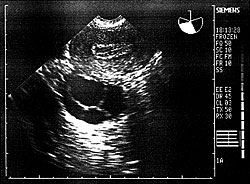
INTRAUTERINE INSEMINATION
When sperm are deposited in the vagina at intercourse, the majority are normally lost because the sperm either trickle out or are destroyed by vaginal acidity. Sperm loss may be a factor when infertility is otherwise truly "unexplained". Sometimes the mucus of the cervix (neck of the womb) can be hostile or very thick and unfavourable. Some men will have problems such as impotence, premature ejaculation or an anatomical abnormality which may make it difficult or even impossible for sperm to be deposited in the vagina. It is quite common to find that the seminal fluid containing the sperm does not liquefy and remains very glue-like. This is likely to be a significant cause of infertility.
In these situations, a successful pregnancy can sometimes result if specially treated sperm are placed into the uterus above the level of the cervix at the time of ovulation. This treatment is called intrauterine insemination or IUI and is a refined form of AIH (Artificial Insemination by "Husband").
It must be stressed that IUI is not a suitable treatment when the sperm count or quality is very poor. Before deciding to commence IUI treatment, a "dummy run" sperm preparation is performed to see whether or not IUI would be a suitable option. If the sperm quality is poor, then IVF or even ICSI may be a more appropriate form of treatment.
The fallopian tubes must also be known to be healthy and open.
The gold standard for assessing the health of the pelvis and the patency of the fallopian tubes is laparoscopy and dye testing. This is performed as a day case under a short general anaesthetic (see laparoscopy information).
A useful alternative to laparoscopy is a hysterosalpingogram (HSG) X-ray. This is performed as an out-patient (see hysterosalpingography information).
Occasionally both investigations may be performed. The tubes may look healthy at laparoscopy, but no dye can be seen entering either tube. This may either be due to a blockage or to spasm of the tubes. An HSG X-ray may then clarify the situation. If the tubal patency test shows that only one tube is open, IUI can only be carried out when ovulation is about to occur from the ovary that is on the same side. This can be frustrating if satisfactory egg growth repeatedly occurs on the side of the blocked tube. In this situation the treatment cycle would be cancelled.
If a "neat" untreated sperm sample is introduced into the uterus, this is likely to cause severe abdominal pain (peritonism) and vomiting as there are many irritant substances in the seminal fluid which do not normally pass along the tubes and enter the peritoneal cavity of the abdomen.
The development of assisted conception has resulted in several specialised techniques of sperm preparation which have a very real application in IUI. A freshly produced sperm sample is prepared by the embryologist in order to isolate the most fertile and vigorous sperm. Unlike an untreated sperm sample, prepared sperm can be placed directly into the cavity of the uterus above the level of the cervix and are therefore protected from the acidity of the vagina and from unfavourable mucus in the cervix.
IUI may be carried out in a natural cycle as long as periods are regular. In a regular cycle it is likely that ovulation will also be a regular and predictable event. This will normally be between days 12 –16 of the cycle (where day 1 is the first day of a period). The clinic may use blood or urine tests to identify when ovulation is about to occur.
If periods are very erratic, ovulation, if it is occurring at all, will be totally unpredictable. In this situation ovulation induction (OI) is carried out with tablets such as clomifene or gonadotrophin injections (see ovulation induction information). Ultrasound scanning is always performed to ensure that good egg development has occurred. Ideally only one egg should grow to reach maturity in order to avoid a multiple pregnancy. As long as there is not a significant risk of more than a twin pregnancy, ovulation is induced with an injection of human chorionic gonadotrophin (hCG). Close to the time of expected ovulation, the prepared sperm are gently introduced into the uterus using a fine catheter tube. This is a painless procedure and should be no more uncomfortable than having a cervical smear taken. The sperm now act as a reception committee for any egg that enters the fallopian tubes.
Figures for Live Birth rates from IUI are not yet available as the collection of this data only commenced in mid-2008. The results are likely to be a little better than the figures given below which are for IUI using donor sperm. This is because the prior freezing of donor sperm usually destroys a proportion of the sperm.
In 2006, the percentage of DI cycles started that resulted in a live birth was:
- 13.5% for women under 35 (13.4%)
- 9.2% for women aged 35-39 (9.7%)
- 5.3% for women aged 40-42 (3.9%)
- 1.2% for women aged 43-44 (1.7%)
- 0% for women aged 44+ (0%)
The figure for 2005 is shown in brackets for comparison.
(Figures by courtesy of the HFEA)
Experience has shown that the majority of pregnancies will occur within three completed treatment cycles. As a generalisation, there is little point in continuing with IUI beyond this number of cycles, unless the alternative option of IVF is not desired.
March 2009
